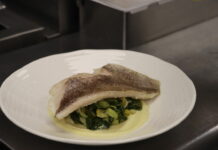It’s 8 in the morning, and already there’s enough smoke rising into the air near mile marker 73 on Route 50 that it wouldn’t be out of line for the fire department to make a courtesy call. For the Trappe Chapter of the Lions Club International, however, the smoke is great advertising. It conveys better than any of the Lions’ red and blue roadside signs that this weekend they are barbecuing.
Although the Lions are known internationally for collecting and recycling eyeglasses, the 70-year-old Trappe club is better known locally for its support of school classrooms and Little League teams— and the monthly chicken barbecues they hold under the pecan tree on the grassy verge across from the Valero gas station. The barbecues are fundraisers that benefit community members dealing with illness. “Local folks looking out for local folks,” quips club president Drake Ferguson, a 96.7 FM WCEI radio personality whose thick hair and beard would earn him the descriptor leonine even if he weren’t a Lion.
The Lions began barbecuing chicken about 15 years ago, Ferguson estimates, but the tradition of civic groups or private entrepreneurs setting up a grill on Route 50 on summer Saturdays and hawking chicken or pit beef goes back long before that— though just how long is up for discussion.
“Since anyone can remember,” is the answer folks have given Cindy Byrd, a curator and folklorist at the Ward Museum of Wildfowl Art in Salisbury who has been researching all things chicken for the museum’s current exhibit, “Something to Crow About: A Cultural History of the Chicken.” Connie Parvis, director of education and consumer information for the Delmarva Poultry Industry Inc., traces roadside barbecues to the 1950s and ’60s, when backyard grilling became popular across the country.
But why chicken, and not say, hamburgers? I ask Ferguson. “Chicken is substantial,” he explains. Half a chicken can satisfy even a demanding appetite. Chicken is also affordable, Byrd points out. And, in a region where the chicken industry dwarfs any other crop, it’s eminently available.
On this third Saturday of the month, the Lions start setting up at 6 a.m. and by 7 a.m. the barbecue team is spreading hardwood charcoal in the box of their brand new, 12-foot, stainless steel grill. Once the coals are hot, Clint Collins, in camouflage shorts and a sprinkling of tattoos, dumps raw half-chickens on the grill, while Jonathan Moore and Alan Eigenbrode, both in black t-shirts and white Lions baseball caps, arrange them. Someone dips a small basting mop into an old Folgers coffee container and shakes a marinade over the chickens, not touching the flesh so as not to contaminate. “It’s more like Carolina-style,” Collins says of the Eastern Shore-style chicken the Lions cook, which features a vinegary, peppery flavor distinct from the sweet, molasses based style found in the southern part of Maryland. As for the Lions’ exact recipe, it’s a secret, says Collins.
That may be, but you can find similar recipes that call for the combination of vinegar, oil, salt and pepper, and poultry seasoning in many Eastern Shorecookbooks. Parvis says the original “Delmarva Barbecued Chicken” recipe originated from one developed in 1953 by the late Robert C. Baker, professor of poultry science and food science at Cornell University that was promoted as an easy (and tasty) way to prepare chicken. The sauce does have its advantages: it can be made in large quantities and has no sugar, so the meat can be slow cooked without the sauce crystallizing or burning. The vinegar-based sauce has become so ingrained on the Eastern Shore that Connie says she’s had folks who’ve traveled out of state return and report, “Those people don’t know how to barbecue chicken.”
There’s no doubt that the Lions have had plenty of practice. When it’s time to flip the chicken, two men set a spare grill grid over one section of chickens, cross their arms at the wrist and grab the grids handles, nod to each other and turn the grids counterclockwise, moving down the grill and turning each section as if they were partners in a silent line dance. It takes an hour and a half for the chicken to cook, and with each turn, out comes the barbecue mop and a dose of marinade. The chicken is judged done, says Jonathan, “by how easily the leg pulls off.”
On a normal Saturday, the Lions barbecue 192 chicken halves, the younger members tending the grill while the long-standing members pack and make change for the $8 dinners, which include a bag of chips and a canned soda.
“Some people have standing orders with us,” says Ferguson. “But we also have the consistency of Route 50. People start looking for us.” People like John Haas, who pulls up in his truck, fresh from picking up crabs from Cambridge for his business, Sea Market Seafood in Pasadena. “I’ve tried every barbecue stand along Route 50, but this one is the best,” he says. “It’s the sauce. I want to make it at home.”
“Is it lemon, vinegar, and Old Bay?” he asks the woman putting together his order. She tells him it’s poultry seasoning— no lemon— and his eyes light up as if he was given the secret to long life.
Cars go by and drivers honk; the Lions wave. A line forms at the cash box. One customer sits at the picnic table under the pecan tree, pulls off a chicken leg without preamble, bites, licks his fingers then washes it all down with a deep swallow from a can of Sprite.
It may be goodwill that brings the men out to stand in the smoke all morning, but it’s the camaraderie that makes them return every third Saturday of the month. “We can’t get into trouble doing this,” Collins says with a wicked grin. It takes hours to grill all those chickens, and additional hours for the grill to cool enough to move. “At 9 o’clock tonight, you still smell like smoke,” he says. “But that chicken still tastes good.”
Delmarva Barbecued Chicken
This is the Delmarva Poultry Industry, Inc.’s recipe for chicken barbecue that’s been adapted over the years from Cornell’s original mid-century version. “The original recipe included a raw egg,” says Connie Parvis, “but when food safety concerns arose with undercooked eggs, we removed the egg and found little difference in taste.” I’ve also seen recipes that use Tabasco sauce instead of cayenne, or call for pepper and even Worcestershire sauce, all which could certainly be added at the cook’s discretion.
12 chicken quarters, legs or breast portions
1 cup cider vinegar
½ cup vegetable oil
1 ½ teaspoon salt
1 ½ teaspoon poultry seasoning
¼ cayenne pepper
In a bowl, make sauce by mixing together vinegar, oil, salt, poultry seasoning, and pepper. Place chicken on prepared grill, skin side up, about 8 inches from heat. Brush sauce over chicken. Cook, turning and basting with sauce every 8 to 10 minutes, about 1 hour or until chicken is fork tender and leg moves freely when lifted and twisted. Makes 12 servings.



